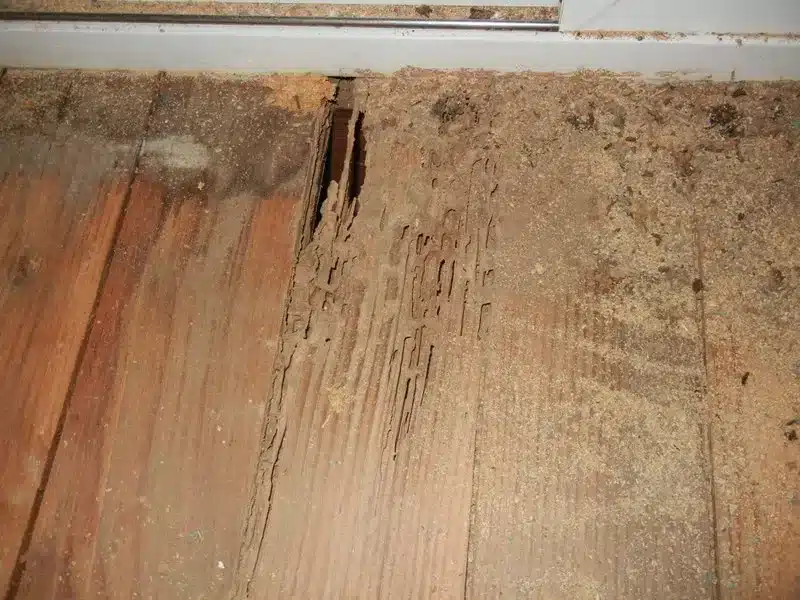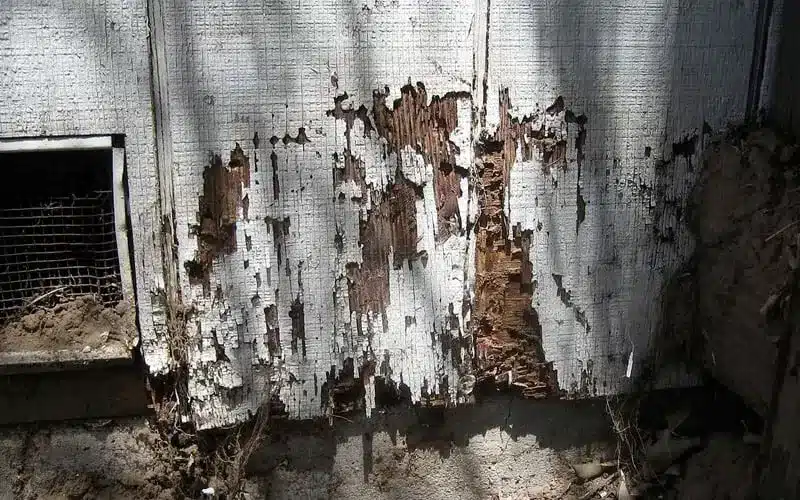How to Identify Termite Damage in Your House
Termites destroy homes as their damage often goes unnoticed. These destructive pests weaken your home’s structural integrity. The damage can make buildings uninhabitable and require expensive repairs regardless of construction materials. Termites don’t limit themselves to wooden structures. They chew through plaster and metal siding to find their food sources. Early detection of termite activity can prevent major structural issues.

Common Signs of Termite Damage in Homes
You can save thousands in repair costs by spotting termite activity early. Here’s what you need to watch out for.

Mud tubes are the most obvious signs that termites have moved in. These pencil-sized tunnels show up along foundations, exterior and interior walls, and crawl spaces. Hollow-sounding wood tells another story. Tap on wood that termites have invaded and you’ll hear an empty or papery sound. These insects eat wood from the inside out, and this hollow effect usually means the colony is several years old.
Discarded wings around windowsills, doors, and light sources mean reproductive termites have arrived to start new colonies. These wings look like tiny fish scales and pile up faster during spring.
Frass (termite droppings) gives away drywood termites’ presence. These pellet-like droppings form small mounds near kick-out holes as termites push waste from their galleries.
Identifying Damage by Termite Type
The type of termite in your home is important in treatment choice and damage assessment. Subterranean termites are responsible for about 95% of all structural damage reported each year in the US. These termites cause substantially more destruction than drywood termites.

Subterranean Termite Damage Patterns
Subterranean termites leave honeycomb patterns in wooden structures. They feed along the grain and target the softer parts between growth rings. The wood’s harder exterior remains intact while the interior becomes hollow and creates a misleading appearance of healthy wood. You’ll find a lot of internal damage with visible termite trails once you remove this thin outer layer. These pests need moisture to survive and build mud tubes to move from soil to wood.
Drywood Termite Damage Signs
Drywood termites create damage that looks completely different. They build their colonies right inside the wood they eat and don’t need soil contact. Their tunnels look cavernous without any specific pattern or direction, unlike the more structured galleries of subterranean species. Frass is the most obvious sign of drywood termites. Termites push these pellets out through small “kick-out holes” which they seal later. You might also spot tiny holes in wooden surfaces where they dump their waste.
Damage Severity Comparison
Both types cause serious destruction, but subterranean termites typically do more damage. This is a big deal as their colonies have hundreds of thousands of members while drywood colonies only have hundreds or thousands.
Professional pest control specialists like Bugmobiles should inspect your property to identify and eliminate these pests the right way.
Where to Look During Your Home Termite Inspection
A good termite inspection means looking at specific areas where they like to hide and feed. You’ll catch an infestation early by focusing on high-risk zones.

Start with your foundation since subterranean termites usually enter here first. Look around the perimeter for pencil-sized mud tubes and check cracks as small as 1/32-inch wide that could let termites into your home. Watch out for moisture issues or pooling water near the foundation that termites love.
Inspect all exterior walls where wood touches soil. Check wooden siding, trim, and deck supports to see if they’re damaged or hollow. Your exterior check should include wooden structures like fences or mulch that can create paths for termites to reach your house. Move to your attic as people often skip this area. Look for damage, moisture problems, or leaks in exposed wooden rafters, support beams, and roof trusses that might draw termites. You should spot any discarded wings, droppings, or damaged wood up there.
Within your home’s interior, knock on baseboards, door frames, and window sills and listen for hollow sounds. Look for these signs.
- Bubbled or peeling paint
- Small pinpoint holes in drywall
- Hollow or springy wood floors
- Warped door and window frames that stick.
Note that termites work quietly and leave few obvious signs. A professional inspection from a company like Bugmobiles can spot termite activity you might miss on your own.
Do You Need Termite Services?
Termite damage threatens your home’s structural integrity, and early detection prevents expensive repairs. A careful inspection of foundations, walls, and wooden structures reveals many warning signs. Bugmobiles has protected South Texas homes from termite destruction since 1954. The company’s experienced technicians identify specific termite species and create custom treatment plans after a full inspection of your property. Call Bugmobiles today for a free inspection to keep your home safe from these pests.
Termite Damage FAQs
What are the most common signs of termite infestation in a home?
The most common signs include mud tubes along foundations or walls, hollow-sounding wood when tapped, frass (termite droppings) resembling sawdust, discarded wings near windows or doors, and damaged or blistering wood surfaces.
How can I differentiate between subterranean and drywood termite damage?
Subterranean termites create mud tubes and leave honeycomb patterns in wood, often filling their galleries with soil. Drywood termites, on the other hand, produce small, pellet-like droppings called frass and create cavernous tunnels within wood without needing soil contact.
Where should I focus my inspection efforts when checking for termites?
Focus on examining your home’s foundation, exterior walls, attic, roof structures, and interior walls. Pay special attention to areas prone to moisture, such as bathrooms and kitchens.
Can termite damage be mistaken for other types of damage?
Yes, termite damage can sometimes be mistaken for water damage or damage caused by other wood-boring insects like carpenter ants. However, termites typically cause more extensive damage and leave behind distinct signs such as mud tubes, frass, or honeycomb patterns in wood.
Is it safe to live in a house with termite damage?
Living in a house with termite damage can be unsafe if the damage is extensive and affects the structural integrity of the building. Termite infestations can also decrease your home’s value.
